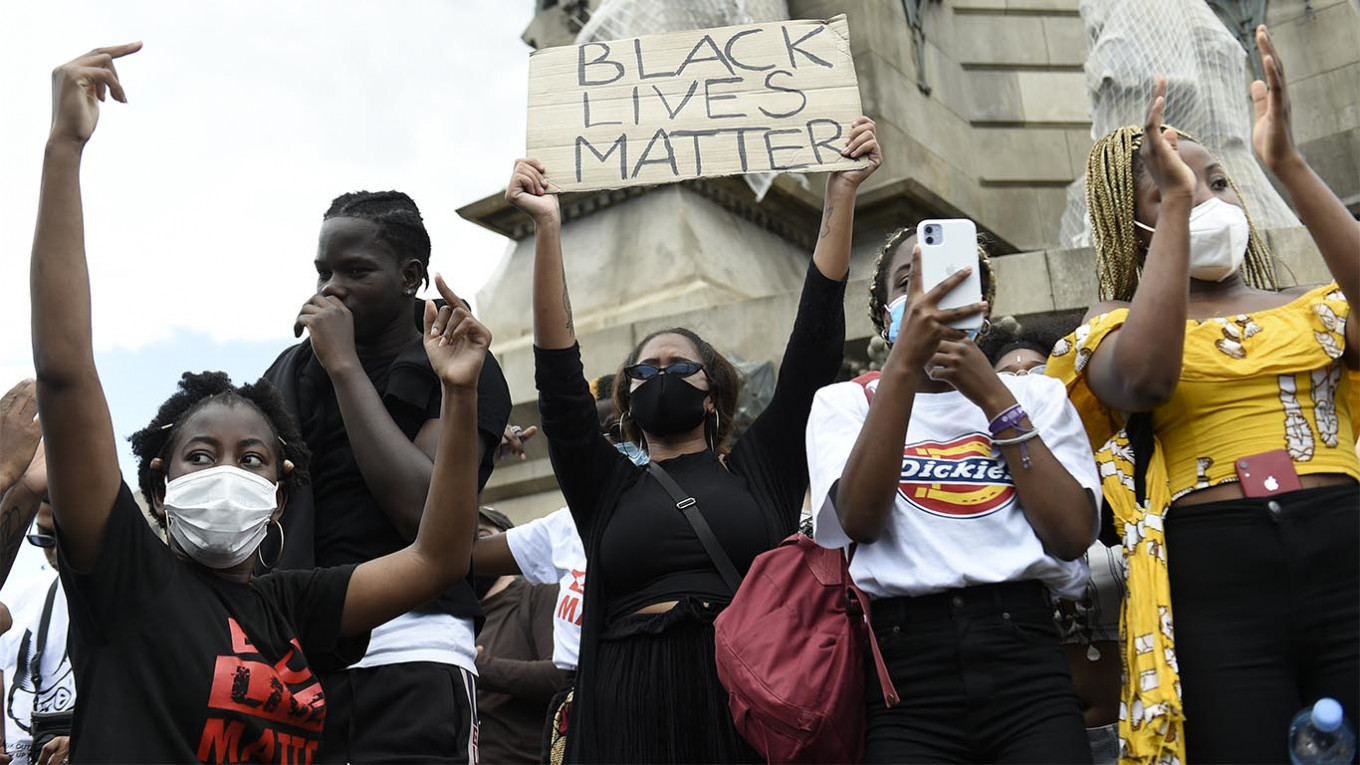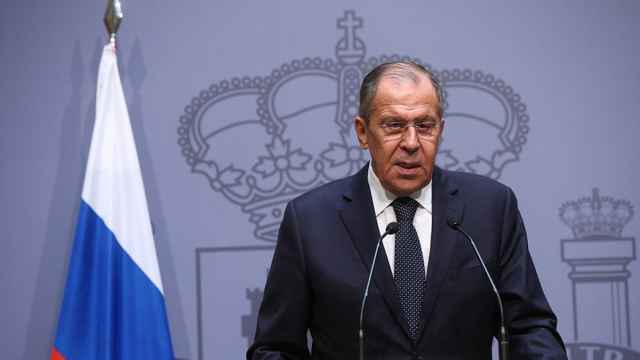The reactions from Russia to the uprisings in the United States against George Floyd’s murder are both maddening and saddening.
Maddening because many Russian pundits are using the protests as an opportunity to spout the vilest racism and display a shameful disregard for its noxiousness. The rhetoric reflects a perverse complex where any expression of solidarity with the racially oppressed smells a hint too “Soviet.”
This kneejerk rejection to the whiff of “Soviet” is also saddening because it’s a disavowal of history, and a missed opportunity to recall a past when the Soviet Union was on the right side of it.
For much of the 20th century the Soviet Union stood in solidarity with people of color and antiracism was a quality of a good Soviet citizen. People of color the world over saw in the Soviet experiment proof that a world devoid of racism was possible. More potent, for many Black Americans who visited and lived in the U.S.S.R., Soviet antiracism provided a rare cathartic experience that briefly muted the historical trauma echoing off their black skin.
This history has much to teach us. The fight for racial justice in the United States today, as it was decades ago, is a chance to renew the internationalism and the promise of a better world, a promise in which the U.S.S.R. played an inspirational role.
It also provides a memory for Russian citizens seeking justice, civil rights, and dignity in their own country to fight racism within, show solidarity, get on board, link up, and be a part of an international movement against oppression.
The Soviet experiment captured many African Americans’ imagination in the 1920s and 1930s. Black radicals were quickly attracted to Bolsheviks’ embrace of anti-imperialism and national liberation. Cyril Briggs, the founder of the black radical journal The Crusader and the secretive African Blood Brotherhood, recalled that his interest in communism “was inspired by the national policy of the Russian Bolsheviks and the anti-imperialist orientation of the Soviet state.”
The historical context is important. At the turn of the century, millions of blacks fled the American South to escape racist terrorism only to find the North held little solace.
The militancy of Briggs and his peers was a direct response to the mass racial violence against blacks in the summer of 1919, and the murderous destruction of Tulsa, Oklahoma’s black community in 1921. American authorities — from politicians to Bureau of Investigation agents — charged Black Americans and “Bolshevik” agitators with instigating the violence. As one historian of federal surveillance of black militancy put it, “behind these nightmares lay the specter of Bolshevik agitators, Bolshevik ideas, and Bolshevik money.”
The fatuity of the “outside agitator” trope, still operative today, was not lost on Briggs. Two months after the 1919 Chicago riot, Briggs emphatically declared in The Crusader, “If to fight for one’s rights is to be Bolshevists, then we are Bolshevists.”
The Bolsheviks, too, were sympathetic to the plight of African Americans, and provided an institutional platform for antiracism.
In his report to the 2nd Comintern Congress, John Reed introduced delegates the horrors of lynching, punctuated by white onlookers taking “home a piece of the clothing or the skin of the Negro they have tortured to death ‘as a souvenir.’”
During his “magic pilgrimage” to the U.S.S.R. in 1922, the Harlem Renaissance poet Claude McKay addressed the Comintern, despite American delegates’ efforts to exclude him. Not only did he denounce racism in the United States, but also the refusal of American communists to take race seriously. Impressed and intrigued, Lev Trotsky commissioned McKay to compose two texts, Negroes in America and Trial by Lynching, for publication in the U.S.S.R.
According to one literary scholar, Negroes in America was “an African American primer for Soviet beginners.”
Such political interventions laid the groundwork for Soviet antiracism in the 1920s and early 1930s that became central to Soviet identity. Soviet antiracism peaked in the early 1930s with the Soviet Union’s leading role in the international solidarity movement for the Scottsboro Nine. In 1931, near Scottsboro, Alabama, nine black teenagers were railroaded on false charges that they gang raped two white women.
The teenagers’ trial took mere weeks for an all-white male jury to convict them. Eight were sentenced to death. Only the 13-year old Leroy Wright got a life sentence. Wright’s mother, Ada, was a visible campaigner who toured Europe in 1932, though illness limited her activity in the U.S.S.R.
The combination of international pressure, persistent campaigning by the defendants’ mothers, the dedicated work of the International Labor Defense (the American Communist Party’s legal arm and part of the Comintern’s International Red Aid, or MOPR) successfully proved the overt racist violation of the Nine’s constitutional rights. The U.S. Supreme Court reversed the Scottsboro Boys’ convictions in November 1932.
The international campaign to free the Scottsboro Boys not only placed American racism under a global microscope, once translated into Soviet ideological parlance, participation in it, as the historian Meredith Roman puts it, was conceived “as a duty of the Soviet people” and “speaking antiracism” a hallmark of a New Soviet Person.
Perhaps the most important contribution of Soviet antiracism was in how African Americans utilized it for their own liberation. The Communist International and its various departments served as key sites for developing a global activist network. In Russia, African American sojourners met activists from Asia, the Middle East, Africa, and Latin America. These interactions provided a basis for placing their fight against American racism as part of a global struggle for humanity.
It is hard to capture the psychological impact this experience had on Black Americans reared in a black-white racial world. In a letter to W. E. B. Du Bois in 1924, Lovett Fort-Whiteman, an early black communist and only known African American victim of Stalin’s terror, wrote, “[Here] are students from all the darker races . . . There is a perfect spirit of internationalism here. Women from various Circassian republics and Siberia, men from China, Japan, Korea, India, etc. all live as one large family, [and] look upon one another simply as human beings.”
This spirit continued into the 1950s and 1960s to inform the postwar American Civil Rights and Black Power movements, long after many African Americans had become disillusioned with the Soviet communism.
Perhaps the most profound experience Soviet antiracism gave to African Americans was the ability to momentarily step beyond their skin. As Kimberly St. Julian-Varnon recently put it, African American experiences in the U.S.S.R. allowed them to think about “what it meant to be black when there isn’t a constant threat of physical, spiritual and psychological violence” from white supremacy.
Langston Hughes often commented about how his black skin didn’t impede his movement in Russia.
His hotel in Moscow had “everything that a hotel for white folks at home would have — except that, quite truthfully there was no toilet paper. And no Jim Crow.” Hughes’ travels took him into what Fort-Whiteman called “a world of tomorrow” where Hughes found himself “forgetting the Russians are white folks.”
“I am riding on south from Moscow and am not Jim-Crowed,” Hughes continued, “and none of the darker people on the train with me are Jim-Crowed.” Hughes wasn’t alone. Margaret Glasgow, a New York City hairdresser who moved to the U.S.S.R. in 1934, wrote to her son, “I’ve quite forgotten that I’m black. I simply feel like a human being; that’s all.” W. E. B. Du Bois said the first time he felt “comfortable and inconspicuous” was in the Soviet Union.
Soviet Russia, however, was far from a raceless paradise.
African American sojourners were not blind to it or completely safe from it. They were not “dupes” or “used” but highly conscious of their role. Anti-blackness then, as now, was a global phenomenon, and despite official Soviet antiracism, racism against dark-skinned people, foreign or domestic, persisted. By the 1960s, racism on the streets and in Soviet institutions became more prevalent as larger numbers of young Africans, Asians, Middle Easterners, and Latin Americans arrived to study, and even remain in the Soviet Union. The more Soviet ideology became a hollow performance, so did the sincerity of antiracism.
Yet, despite its complicated history, Soviet antiracism was ahead of the historical curve, and the Black voices finding agency in its sincerity should not be silenced. Its successes, failures, and mistakes can still serve as crucial bases for historical reflection and political action. Because when Russians — and us — wholly reject the Soviet promise as a sham, they not only undermine their own traditions of international solidarity, they also risk disavowing the broader systems of oppression and potential allies in fighting them at home and abroad.
A Message from The Moscow Times:
Dear readers,
We are facing unprecedented challenges. Russia's Prosecutor General's Office has designated The Moscow Times as an "undesirable" organization, criminalizing our work and putting our staff at risk of prosecution. This follows our earlier unjust labeling as a "foreign agent."
These actions are direct attempts to silence independent journalism in Russia. The authorities claim our work "discredits the decisions of the Russian leadership." We see things differently: we strive to provide accurate, unbiased reporting on Russia.
We, the journalists of The Moscow Times, refuse to be silenced. But to continue our work, we need your help.
Your support, no matter how small, makes a world of difference. If you can, please support us monthly starting from just $2. It's quick to set up, and every contribution makes a significant impact.
By supporting The Moscow Times, you're defending open, independent journalism in the face of repression. Thank you for standing with us.
Remind me later.








